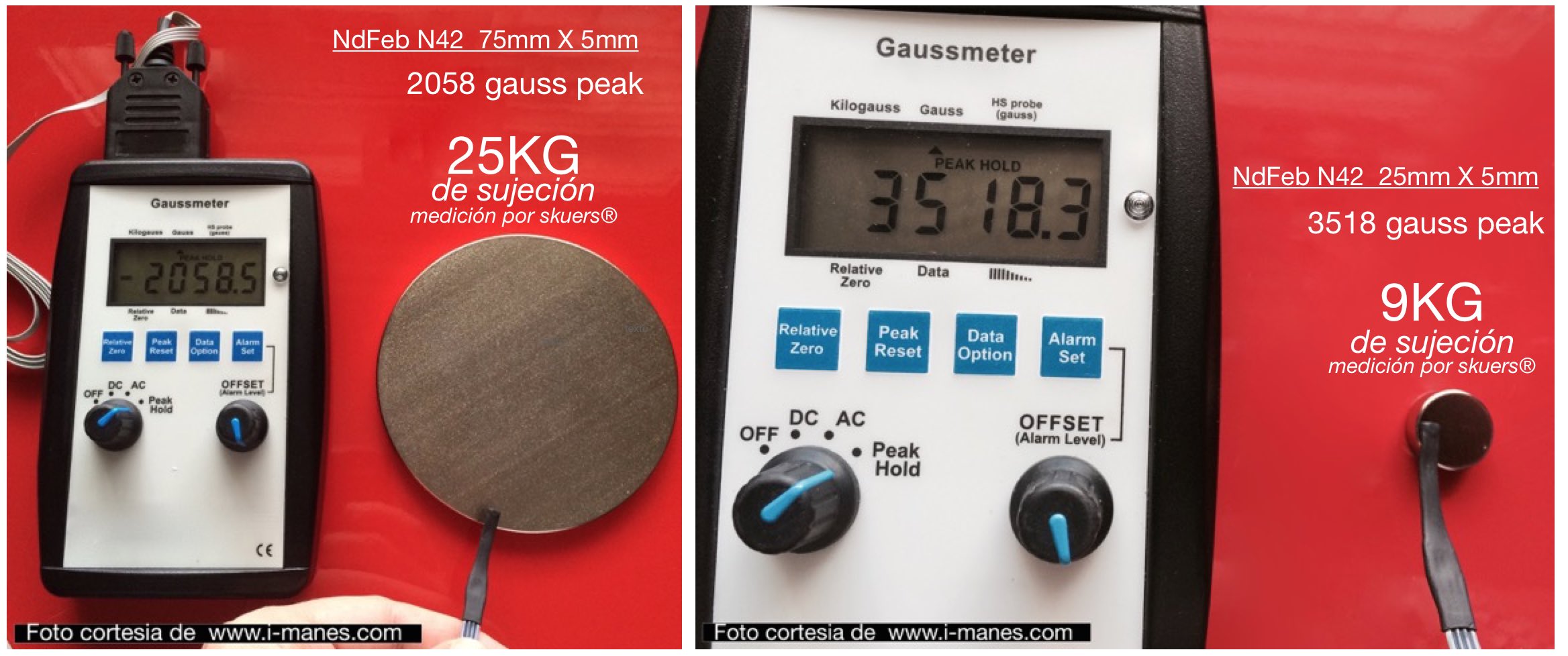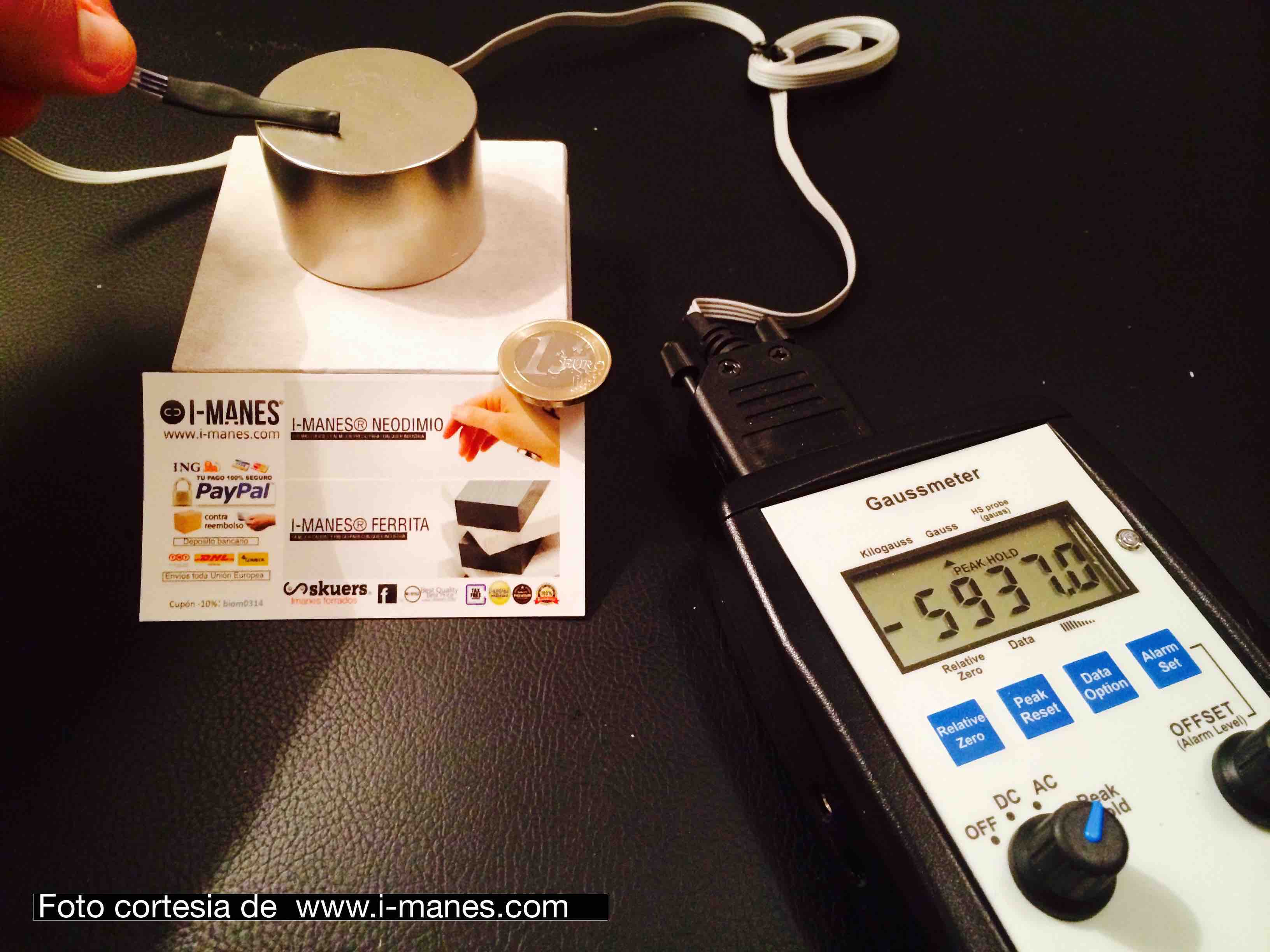The Gauss is a unit of measurement, this unit is used to measure the density of magnetic flux or magnetic induction. This unit is named after the German mathematical physicist Karl Friedrich Gauss, who developed and applied mathematical principles to a magnetic field in 1840.
The magnetic flux is the amount of magnetism exerted by the magnet or a magnetized body, but this amount is quickly lost with distance and the latter is the most important observation to understand that the gauss is not the unit that should matter most to the Biomagnetism.
In fact, the gauss are better concentrated and are higher in small magnetized bodies, since the larger the magnet, the more it will disperse the magnetic field and therefore the gauss will be distributed always concentrating at the end of the mass, being the center of the magnet the one with the least gaussage charge present.
The other condition point of the gauss in a magnet will be its thickness, being that the wider it is, the stronger the gaussage value will be.
The third point, if it is not that it should be the first to determine the high or low gaussage of the magnet, will be both the material and the quality and degree of magnetization.
For example, in Neodymium magnets, which are really an alloy of NdFeB (Neodymium + Iron + Borro) to which a solid protection must be placed, which is generally Nickel, the degree of magnetization ranges from N35 to N52, being that the most recommended grade for Biomagnetism is the medium grade, N42.
In the following image we can see a Gaussmeter measuring the Gaussian peak at the ends of two NdFeb N42 magnets of different sizes. In the first photograph you can see a 75mm X 5mm magnet showing 2058 gauss, while in the second photograph we see a 25mm X 5mm magnet showing 3518 gauss, that is, between these magnets there is a difference of 1500 more gauss in the little.
The Gauss measurement of a magnet can be misleading, since the magnetic flux falls very quickly from the surface of the magnet while the pipette moves away from the same magnet, therefore this measurement is variable, determining the area of the magnet where it is taken and the distance .
On the same photograph, let us imagine that by separating the pipette 0.5 cm from the magnet, 50% of the gauss charge will be exhausted and by separating 4 cm it will have been exhausted at 90%, which would only leave 350 gauss for the small magnet at this separation. .
This is why the gauss measure should not be as relevant as it is believed. The only criterion that must be taken into account about how many gauss a magnet must have to be effective in Biomagnetism is the fact that a magnet has a minimum of 1000 gauss, we return to the primary and basic golden rule that the father of Medical Biomagnetism, the doctor Goiz dictates.
There are no permanent magnets with more than 6500 gauss!
Urbanly, it has been speculated and assimilated with the enormous amounts that a magnet must have to be effective in Biomagnetism. These myths started from the fact that Doctor Goiz talks about a magnet being effective for therapy in the range of 1,000 to 10,000 gauss. Even in his first book "The Biomagnetic Pair" he talks about it and he was not wrong if not quite the opposite.
At that time of the discoveries of his first pairs, it was extremely difficult to obtain a gasometer as well as technical information on the magnets, so he limited himself to measuring the gaussage of the magnets with kinesiology and the result he obtained was obviously the internal gaussage of the magnet, but when doing it with the gaussmeter the external gaussage is measured.
The internal gaussage of a magnet is almost 4 times greater than the external gaussage, so to know the internal gauss it is enough to multiply the number that the gaussmeter shows by 3.9.
This is where the excessive amounts of gauss that a magnet can have started, at the same time, many magnet peddlers took advantage of saying that their magnets had 5, 15,000 and even 20,000 gauss in order to sell without any serious justification or technique. Even many therapists were the ones who were selling the magnets with supposed gaussages, since they were just reselling the magnet without really knowing the true gauss of these magnets.
The most powerful magnets that exist to date are those of NdFeb. The appearance of this magnet is
It goes back to 1982, when General Motors together with an important Japanese group discovered the use of NdFeb and its ability to permanently magnetize it, then they patented it.
NdFeb magnets are permanent magnets that cannot naturally reach more than 6,500 gauss. The way to bring them to a higher gaussage is by electrifying them, but this would already be a risk to Biosafety and health because it becomes radiation if it is directly exposed to the human body.
The following image shows a 45mm X 35mm NdFeB N45 magnet that is very close to reaching 6 thousand gauss. This magnet is dangerous since it has a holding force of almost 90KG which was used in the office of a prominent therapist to impact patients who were not having improvement with Biomagentism as well as regular patients in the office. The conclusion was that the performance obtained with this magnet was no better than that obtained with regular NdFeb magnets.
So what is the key element to notice in the magnets for Biomagnetism?
We have seen that although it is essential that magnets have a minimum magnetic flux or greater than a thousand gauss, the determining factor in therapy is the distance of the magnetic field that the magnet can exert. This distance will be determined firstly by the length or diameter of the magnet and secondly by its thickness.
A magnet has to be strong enough to penetrate deeply into human tissues and hence also the size of the area of the area or organ to be treated. Thus, the determining indicator to know the distance of penetration will be the KG of subjection, which are determined by the manufacturer or can be found with a scale in reverse. The greater the size of the magnet, the greater KG of clamping or force it will have and, therefore, greater penetration.
With the purpose of having an equation that determines a proper form as an indicator of the magnets to use and take into account in biomagnetism, a server, and author of the research, I Joe Pardo have determined as a solution the biomagnetic gauss unit, unit different from the gauss unit, where I have come to conclude with the following formula:
((external gauss) x (clamping force)) / (4)
- The external gauss are taken, the most correct way to take them is with a gaussmeter, although they can also be obtained by means of a complex mathematical formula, which gives us an approximation where to make the equation, the measurements of the magnet and the flux must be applied. residual, in the case of NdFeb it is 13000 and in ferrite it is 4000 in a medium magnetization.
- Multiply the external gauss by the clamping force (direct clamping to a non-porous iron plate, not to another magnet.)
- Divide the amount by the fourth force of physics with the number 4.
In this way, the therapist can rely on a determining measure for the technique and its exercise called Biomagnetic Gauss, which should always be at least 1,000 biomagnetic gauss and will know that the higher the number, the greater the penetration distance in the body will have the magnet.
As examples in the penetration distance with NdFeb fields:
A 3,000 gauss biomagnetic magnet has a penetration distance of 3.5 cm.
A 5,000 gauss biomagnetic magnet has a penetration distance of 4.5 cm.
A 7,000 gauss biomagnetic magnet has a penetration distance of 6.5 cm.
A biomagnetic 11,000 gauss magnet has a penetration distance of 8.5 cm.
A 13,000 gauss biomagnetic magnet has a penetration distance of 9.5 cm.
A 17,000 gauss biomagnetic magnet has a penetration distance of 11 cm.
However, after 10,000 gauss biomagnetics, the penetration distance ratio is less and less.
By having a magnet with, say, 11,000 biomagnetic gauss, the most relevant parameter than the distance would be the terrain it covers, since due to the high measure of biomagnetic gauss we can assume that it is a large magnet and therefore large organs must be covered with a large magnet unless you already have a fine sense of placement on the point to be treated, however with the size we will eliminate the margin of error due to poor positioning.
Now, as for the ferrite magnet, this material has a different behavior in its magnetic field, it has a greater strength but more limited. That is to say, it will be difficult to obtain a ferrite magnet greater than 2 thousand external gauss and 5 thousand biomagnetic gauss, in addition to the fact that it would be very large and heavy.
As examples in the penetration distance with Ferrite fields:
A 1,000 gauss biomagnetic magnet has a penetration distance of 4.5 cm.
A 1.2 thousand gauss biomagnetic magnet has a penetration distance of 5.5 cm.
Update: April 10, 2015
All the information contained in this article is typical of the author's intellect, his experience and research, and there are cases of people who copy it to claim it, falling into plagiarism, which in addition to being a lack of morals is a constitutional crime.
Geographic Poles and Magnetic Poles! What is the real Pole?
The earth has a NORTH POLE and a SOUTH POLE, these poles are called GEOGRAPHICAL POLES and, like living beings and humans, we also have A NORTH POLE and A SOUTH POLE similar to the planet earth on which we live, however, in electronic devices. measurement is BACKWARDS, the poles are inverted and are called MAGNETIC POLES... why is this? Very simple.
Since the earth is a gigantic magnet with its NORTH POLE located above Europa, then a MEASURING MAGNET such as a compass must mark NORTH with its SOUTH side, since opposite charges attract, so if If a magnet wants to take us to the North Pole, we must do it with the negative side, that is, the SOUTH side.
The magnetic poles must be different from the geographic ones, because if this were not the case, a compass would not work correctly, that is why the magnetic poles are marked inversely than the geographic ones. People who have conflicts about which is the appropriate POLO is because they ignore this simple information.
Now, living beings and human beings are made in the likeness of mother earth, our polarity is the same and if we want to level the energy charges of the body, let's say alkalinity has a negative charge (-) (more hydrogen) and acidity that is positive (+) (minus hydrogen ions), we must do it by pushing the polarity equal to that of the earth and in this way there GEOGRAPHICAL NORTH and GEOGRAPHICAL SOUTH-
With this foundation, one can realize how some therapists and therapies apply magnets in a contrary way, not to mention that they also do it unipolarly.
IN CONCLUSION: The easiest and most appropriate way to locate the polarity of a magnet to use it under the Biomagnetic Pair technique of Medical Biomagnetism is to face a magnetic compass to the magnet, where the compass indicates north means that it is the negative north pole which it is lined or marked generally black.










